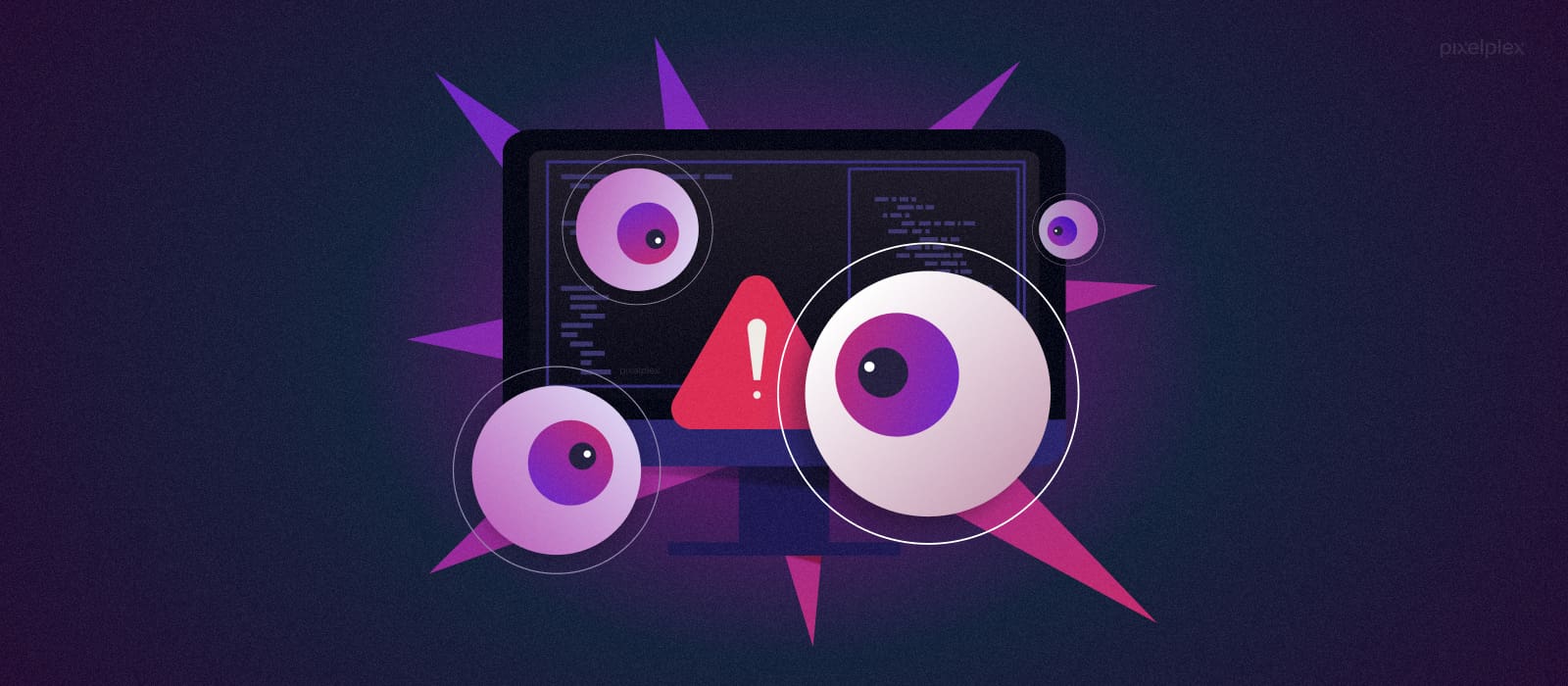Cybercriminals never sleep. They are constantly creating new ways to find and exploit vulnerabilities in a company's systems which could lead to data breaches, financial losses, and, unavoidably, reputational damage.
Applying strong security measures and hiring IT security audit professionals is expensive, but data breaches and cyberattacks cost businesses many times more, and the price is only going up.
The Cost of a Data Breach Report 2023, published by Ponemon Institute and IBM Security, reveals an all-time high average cost of a data breach — $4.45 million. This is 2.3% more than in 2022 ($4.35 million).
The report also emphasizes the importance of early detection and remediation of cybersecurity issues. On average, breaches detected within 200 days cost $1.02 million less than those discovered later.
Therefore, it is vital for businesses to understand the risks, know what types of threat they may face, and try in every possible way to prevent them from becoming a reality. Now, let’s get into the details.
What are cybersecurity threats?
Cybersecurity threats are any type of malicious activity that aims to steal data or damage, disrupt, or gain unauthorized access to digital systems, devices, or networks. These threats can come from different sources: from insiders in an organization, hackers, or organized crime groups.
The impact of cybersecurity threats can be significant regardless of who initiates the hack or how big it is. For businesses, they often lead to sensitive data loss, intellectual property theft, regulatory penalties, and huge financial damage.
Find out how our security solution protects users against intellectual property theft in web3
What are the main types of cybersecurity threats?
![]()
Our research and development consulting team shortlisted the most common types of cybersecurity threats that both individuals and companies face. These are malware attacks, a Domain Name Server (DNS) attack, and advanced persistent threats (APTs).
Malware
Malware stands for malicious software. It is designed to harm computer systems, steal data, or disrupt network operation. Viruses, worms, trojans and spyware are among the most common types of malware.
Malware usually gains access to the system through links or emails. If an employee clicks on a link, the malware is activated and can severely disrupt vital components of your network, compromise your system’s integrity, and transfer sensitive data to wherever the hacker wants it to go.
To prevent this, businesses need to implement security measures such as installing antivirus software, using firewalls, and keeping software up to date. More importantly, they should conduct proper cybersecurity training for their employees to prevent risky scenarios.
Phishing
Phishing attacks occur through online communication. The attacker uses emails or messages on social media to talk to the victim and trick them into sharing their credentials, password, credit card number, or any other sensitive information that will help them access and steal funds.
Attackers are often good at acting and employing psychological manipulation, and they use strong social engineering tactics so that even the most cautious person can fall victim to an attack.
The Ponemon Institute and IBM Security report states that phishing represents 16% of data breaches, resulting in losses of $4.76 million per breach.
Ransomware
Ransomware is software that encrypts a victim’s files or blocks access to their computer system, making the data inaccessible until a ransom is paid. The attacker can also threaten the victim that the data will be exposed unless they agree to pay them, and they usually demand a payment in cryptocurrency.
Ransomware is often spread through phishing emails, malicious websites, or software vulnerabilities.
Ransomware attacks can cause significant business disruption because they prevent employees from accessing the system, and even if a ransom is paid, the company still cannot be sure that access will be fully restored or that data will not be disclosed to the public.
Distributed denial-of-service (DDoS)
A DDoS attack involves taking down your company’s website and consequently disrupting the normal functioning of your online services by sending multiple requests to the server.
The requests are sent from numerous computers and devices that have been infected with malware. This turns them into bots that are controlled remotely by the attacker while the device owners may not even know what’s happening.
As traffic floods the server, it becomes overwhelmed and stops responding to requests from real users trying to access the website. This results in the website becoming slow or often completely unavailable, and consequently — you lose clients and reputation.
Domain Name Server (DNS)
The purpose of the Domain Name System is to translate domain names into machine-readable IP addresses. If a DNS attack occurs, it means that hackers have exploited vulnerabilities in the DNS infrastructure and redirected traffic destined for a specific website or service to a different IP address.
In a DNS attack, legitimate users trying to access a website are redirected to malicious pages. The attackers may also be able to steal sensitive data from compromised systems.
Advanced persistent threats (APTs)
APTs are very sophisticated attacks that target specific organizations. These attacks can be particularly challenging to detect and may remain unnoticed for an extended period of time, allowing the attackers to collect sensitive information and continuously monitor the activities within an organization’s systems.
APTs typically involve a high degree of planning, skill, and resources, and are a significant threat to organizations of all types and sizes.
Want to know more about how to provide adequate security for your application tech stack? The answers are right here
What cybersecurity threats do businesses need to be aware of in 2025?
![]()
Every year cyberattacks become more and more sophisticated, as scammers come up with new ways to deceive users. In 2025, the following types of scam are likely to be the most widespread: cloud breaches, IoT threats, exploiting smart contract vulnerabilities, threats associated with mobile devices, and taking advantage of cybersecurity skills gaps.
Let’s take a look at each of these risks in greater depth.
Cloud breaches
The Ponemon Institute studied 553 organizations affected by data breaches occurring between March 2022 and March 2023. 82% of those breaches were associated with cloud-based systems.
Another report claims that the world will store more than 200 zettabytes of information in the cloud by 2025, making cloud systems even more vulnerable and attractive to hackers.
As an increasing number of companies are adopting cloud-based software, it is vital to implement strong security protocols such as robust passwords, encryption, multi-factor authentication, and consistent monitoring and updating of cloud systems.
Smart contract hacks
Smart contracts are self-executing digital contracts with the terms of the agreement directly written into code. They can be implemented on any platform or technology that allows for programmable code execution. However, blockchain technology, due to its decentralized and immutable nature, is the most suitable tech for implementing such functionality.
The global blockchain market is predicted to grow from $17.57 billion in 2023 to $469.49 billion by 2030, a CAGR of 59.9% during the forecast period. As blockchain technology gains traction across various industries, more businesses are adopting it to streamline operations, improve transparency, and reduce costs by eliminating intermediaries.
However, attacks on blockchain systems and cryptocurrencies are skyrocketing. Between January 2024 and November 2024, more than $1.75 billion worth of crypto was lost due to hacks. How? The hackers exploited vulnerabilities in unprotected wallets, hacked SIM cards, or gained access to recovery phrases and passwords.
At the same time, one of the most serious problems associated with the implementation of this technology is smart contract vulnerabilities: flaws in the code that hackers can take advantage of.
To address these vulnerabilities, businesses need to conduct regular security audits to identify and fix any problems in the code. Companies can also implement a bug bounty program. This kind of program incentivizes security experts to actively search for and report any vulnerabilities, instead of exploiting them for their own gain.
The PixelPlex blockchain team can help you develop or audit your smart contracts and ensure their security
IoT threats
Companies and individuals are surrounded by smart devices that constantly track and collect data.
IoT devices, however, can pose a significant threat to businesses as they can provide cybercriminals with access to sensitive information such as private conversations, images, locations, and access to any accounts attached to the devices. This information can easily be exploited by attackers for blackmail or personal gain.
Businesses therefore need to take measures to secure their devices and networks and prevent unauthorized access and data breaches.
Threats associated with the use of mobile devices
In the US alone, more than 253.3 million people are currently using mobile devices, which is approximately 75% of the country’s population. Mobile phones are used for personal reasons and at work, and they will be connected to several different networks during the average day.
The widespread use of personal mobile devices in the workplace, also referred to as BYOD (Bring Your Own Device) policies, can pose numerous security risks for businesses. These include data breaches caused by malware and phishing attacks, as well as unsecured Wi-Fi networks.
To mitigate these threats, businesses should implement strong mobile device management policies: regular security updates, training employees to use mobile devices safely, and using software to remotely wipe devices if they are lost or stolen.
Taking advantage of cybersecurity skills gaps
This type of risk is always relevant. Most security threats can be avoided if employees simply don’t click on questionable links and know how to protect their personal and work devices.
Unfortunately, even the most careful employee can become a victim of a cyberattack, because attacks are becoming ever more sophisticated.
How can your business prevent cybersecurity risks?
![]()
The first essential steps that you as a business owner need to take include training cybersecurity staff and customers, implementing risk management programs, segmenting your network, and integrating security tools into your organization’s system.
Cybersecurity education
The first thing you need to do is organize regular cybersecurity training for your employees to show them what security measures they can personally apply and how they can avoid clicking on suspicious links and websites. We know this may sound too primitive for the 21st century, but such a simple action may save your company millions of dollars.
You should take the training of remote workers seriously as well. In fact, there is a strong correlation between remote work and data breach costs: more employees working remotely are associated with higher data breach costs.
This does not mean that they should come back to the office — that would be a huge backwards step. Instead, just make sure that they are aware of all the possible security risks and know how to minimize them.
Risk management program implementation
Any company is exposed to some sort of risk: no one is 100% safe. To mitigate these risks and prevent threats, an organization needs to establish a risk management program.
Creating such a program involves working together with cybersecurity specialists to analyze and identify possible risks, determine the company’s risk tolerance, and propose specific risk mitigation strategies for each scenario. If there is an actual threat, the organization will be ready to handle it properly and will minimize the potential financial losses and damage to its reputation.
In addition to this, you should conduct regular backups and develop a disaster recovery plan.
Network segmentation
Network segmentation is the process of dividing a computer network into smaller subnetworks. If a hacker successfully accesses one such segment, if it is isolated from the rest of the network they will not be able to gain access to the entire system. Thus, network segmentation provides multiple layers of security, making hackers’ lives that much more difficult.
Implementation of security AI
Given the rapid evolution of artificial intelligence capabilities, businesses can leverage the technology to enhance their cybersecurity. As stated in the Ponemon Institute and IBM report, it took 108-day shorter time to identify and contain the breach for the enterprises that used security AI. Additionally, they reported data breach costs that were USD 1.76 million lower compared to organizations that did not utilize security AI and automation capabilities.
Discover more details about using AI in cybersecurity in our article
Integration of security tools
Hackers work hard, but developers work even harder. They build solutions that help organizations and individuals protect their networks and data against different types of cyber threats.
Web3 Antivirus is one example. It protects users against security threats in the web3 space, which is not a thing of the far future — that future is already here.
Web3 Antivirus can now spot phishing and fake websites, malicious code patterns, poisoning attacks, honeypot scams, and dangerous signature requests. The range of risks that it can detect and alert its users about is constantly expanding.
Since its official release on December 1, 2022, this security tool has detected more than 2 million dangerous contracts and blocklisted over a million websites.
Businesses can incorporate this solution into their workflows. This will help employees receive warnings about potential dangers in good time.
XDR solutions have also proven to provide effective tools in this never-ending battle against cyberattacks. XDR stands for extended detection and response. These solutions gather data from various silos within an IT environment to enhance risk detection, investigation, and response, resulting in improved process speed and quality.
According to research by the Ponemon Institute, XDR has reduced average breach costs by 9.2%. In addition, companies that implemented XDR solutions were able to detect and contain security breaches 29 days earlier than those who did not use XDR.
Check out these top 5 web3 security tools that can help you safeguard your organization
Closing thoughts
Cybersecurity is not something that businesses can ignore or delay investing their time and money into. As the threat landscape is constantly evolving, businesses must take proactive steps to protect themselves against cyber threats and ensure that their software is free of bugs and vulnerabilities.
The PixelPlex custom software development services specialists understand how crucial security is in today’s digital age and prioritizes it in every step of their work. With our expertise and commitment to security, businesses can trust us to build sophisticated yet safe solutions and be confident that their data and network will not be compromised by cybercriminals.
Ready to discuss your ideas or want us to help improve your solution? Just drop us a line and our specialists will get back to you as soon as possible.




